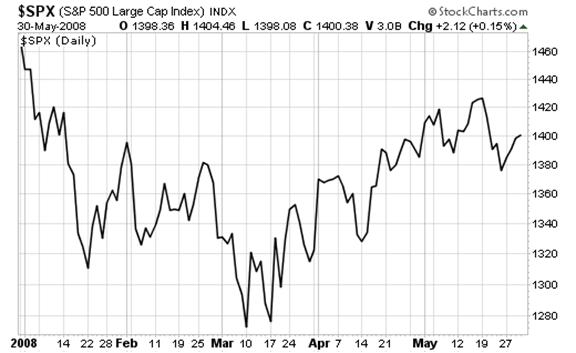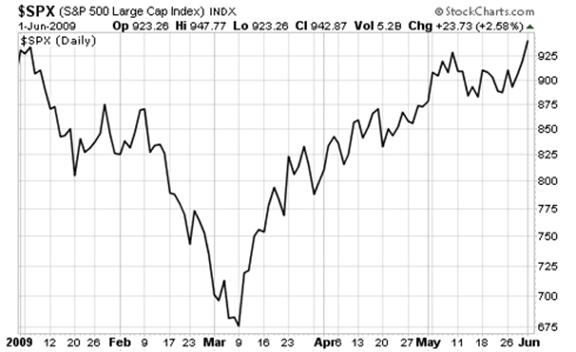Why the Mainstream Financial Media Could DESTROY Your Stock Portfolio
Stock-Markets / Seasonal Trends Jun 12, 2009 - 01:04 AM GMTBy: Graham_Summers
 Welcome to Groundhog Day.
Welcome to Groundhog Day.
Last year, when Bear Stearns went under and the Federal Reserve intervened via Bear’s shotgun marriage to JP Morgan, the mainstream financial media went absolutely berserk with the “unprecedented market action.” Stocks then rallied in the three months following this, despite the economic and financial fundamentals worsening considerably. However, by the time the summer rolled around, things started to get ugly. And by the 3Q08… well I don’t think anyone wants me to remind them of what happened then.
The first half of 2008…

And the SECOND half…

Despite the media’s claims to the contrary, the Bear Stearns deal and subsequent rally were in no way unprecedented. There had already been three March financial crises/ bottoms and subsequent interventions in the 20th century alone-1907, 1929, and 1980. And while the ones intervening changed - JP Morgan in 1907, Herbert Hoover in 1929, and Jimmy Carter in 1980- the effects of the interventions were always the same: the intervention marked a temporary bottom followed by a brief two to three month rally, then a very ugly fall (literally and seasonally).
We’ve now added 2008 to the list of March bottoms/ interventions. And here we are, one year later, with the same exact trend playing out: a March low/ intervention (Obama’s $700 billion stimulus) followed by a summer rally (see chart below). Investors and pundits alike are excitedly claiming that the bull market has begun anew and the economy is showing “green shoots” of growth.
The first half of 2009…

The similarities between 1H08 and 1H09 are striking. Both followed March crisis/ interventions (Bear Stearns and Market Crash/ Obama’s Stimulus), both were initially dominated by short covering, both were lead by the previously worst performing sectors (financials), and both weakened in May.
Aside from the March Crisis/ summer rally pattern, there are also seasonal trends to consider. According to the Ned Davis (NDR) database, had you invested $10,000 in the S&P 500 every May 1st starting in 1950 and sold October 31 of the same year, your initial position would only be worth $10,026 today. Put another way, by investing only from May through October, a $10,000 stake invested in 1950 would have only made $26 in 57 years.
In contrast, $10,000 invested in the S&P 500 on November 1st and sold April 30th would have grown to $372,890. Out of 58 years, you would have had 45 positive and only 13 negative.
Thus, we have two powerful trends (seasonal and crisis specific) playing against the market today. It’s also worth noting just how overbought this market it. According to David Rosenberg (former Chief Economist for Merrill Lynch and one of the few big name economists who gets it right), not once in the last 60 years has the S&P 500 surged more than 40% prior to a recession ending. Instead, when the S&P 500 rallied 40%+ or more, the US was usually not only no longer out of recession but was nine months into recovery mode.
Now, the current consensus is that this recession will end in September 2009. If this consensus is correct (it isn’t as I’ll explain in another essay) then this 40+% rally puts the market where it should be trading in May 2010: a full year from today based on the rosiest economic view possible.
Seem to me we're due for a serious pullback in the next few weeks. And if 2009 plays out anything like 2008, the fall is going to be an absolute nightmare. I'll detail why I think this will be the case in tomorrow's essay. In the meantime…
I’ve prepared a FREE Special Report detailing three investments that will soar when the Second Round of the Financial Crisis hits. I call it the Financial Crisis Round Two Survival Kit. Swing by www.gainspainscapital.com/roundtwo.html to pick up your free copy today.
Good Investing!
Graham Summers
Graham Summers: Graham is Senior Market Strategist at OmniSans Research. He is co-editor of Gain, Pains, and Capital, OmniSans Research’s FREE daily e-letter covering the equity, commodity, currency, and real estate markets.
Graham also writes Private Wealth Advisory, a monthly investment advisory focusing on the most lucrative investment opportunities the financial markets have to offer. Graham understands the big picture from both a macro-economic and capital in/outflow perspective. He translates his understanding into finding trends and undervalued investment opportunities months before the markets catch on: the Private Wealth Advisory portfolio has outperformed the S&P 500 three of the last five years, including a 7% return in 2008 vs. a 37% loss for the S&P 500.
Previously, Graham worked as a Senior Financial Analyst covering global markets for several investment firms in the Mid-Atlantic region. He’s lived and performed research in Europe, Asia, the Middle East, and the United States.
© 2009 Copyright Graham Summers - All Rights Reserved
Disclaimer: The above is a matter of opinion provided for general information purposes only and is not intended as investment advice. Information and analysis above are derived from sources and utilising methods believed to be reliable, but we cannot accept responsibility for any losses you may incur as a result of this analysis. Individuals should consult with their personal financial advisors.
Graham Summers Archive |
© 2005-2022 http://www.MarketOracle.co.uk - The Market Oracle is a FREE Daily Financial Markets Analysis & Forecasting online publication.



